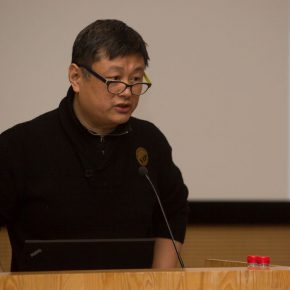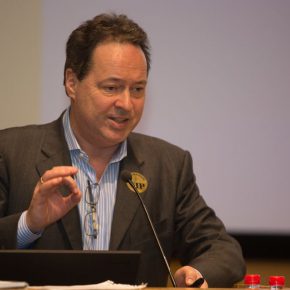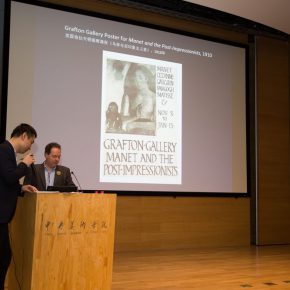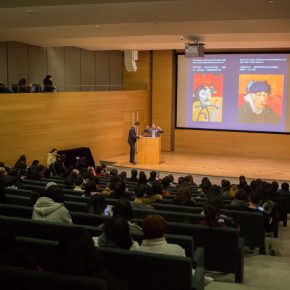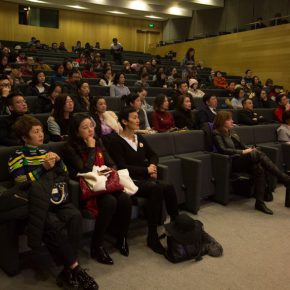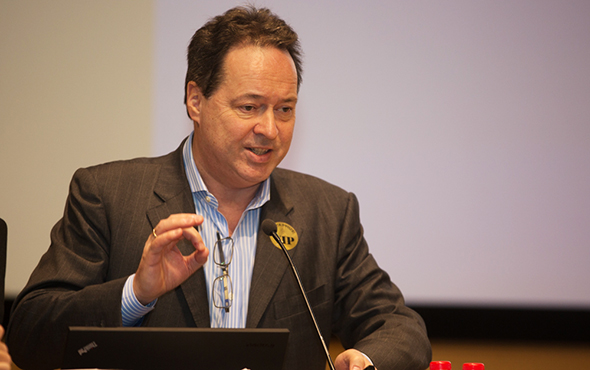
At 14:00 on January 12, 2017, the Institute of Arts Administration and Education at CAFA series of Academic Lectures, "Today - How Are We Related to the Modern, Has It Been Too Late?" was held at the Auditorium of CAFA, and the speaker was Prof. Joachim Pissarro from the Hunter College in New York, the host was Prof. Zhao Li from the Institute of Arts Administration and Education at CAFA.
Prof. Joachim Pissarro serves as the Director of the art museum of the Hunter College in New York, and the curator of the Department of Painting and Sculpture at MoMA in New York, a senior curator at Campbell Gallery in the United States and the gallery of Yale University, he has planned a series of important exhibitions with diverse content.
Prof. Joachim Pissarro is interested in the history of Western art, especially the concept of "modern art", which is related to his experience of MoMA's curatorial work. Today, it is necessary to answer a complex question: What is modern art? What did it mean in the past, what does it mean today, what does it mean for the future?
First of all, Prof. Joachim Pissarro reviewed a section of history, which allowed the audience to understand MoMA's DNA as well as the boundary of the discussion. When MoMA was founded in 1929, the founder Alfred H. Barr was very young, and he was a student of Harvard University, he had not yet received a doctorate in art history. Barr's icon is a British art historian and the curator Roger Fry, who created the essential terms for the important "Post-Impressionism", it has been 107 years since the concept was proposed. Interestingly, the concept was proposed by a British man but is mainly used to refer to the artists of the French school, the artists included Gauguin, Van Gogh, Matisse, who were active in the art circles at the end of 19th century and the early 20th century.
Then Prof. Pissarro talked about the change of people's views on modernism from 1910 to 1929. Proposed in 1910, the concept of Post-Impressionism laid the foundation of modernism, when Roger Fry curated the "Manet and the Post-Impressionists" in Grafton Gallery, it was a scandal. After 19 years, the opening exhibition of MoMA, presented the same artists had achieved a great success. Barr was deeply influenced by Roger Fry and on the basis of his exhibition, Gauguin, Van Gogh, Cézanne were selected and he added Georges Seurat to the opening exhibition, and these four artists were called "The Four Major Pillars of Modernism". Roger Fry paved the way for his "spiritual son" Alfred H. Barr, and Post-Impressionism became a future landmark for the American modernism and the cornerstone of MoMA. Barr's opening exhibition replicated Roger Fry's exhibition in 1910, but the public attitude and opinion were changed, the exhibition created a concise language of art. The goal of Barr's team was to interpret and promote this new art language, to allow people to know what modern art was and where modern art came from. Summarizing the two tasks of Barr, on the one hand, MoMA gave an art history of modernism, on the other hand, it drove people to love modernism.
What is the real core of MoMA? Compared with the traditional art museums such as the Louvre and the National Gallery, London, the definition of the MoMA is different. In 1933, the first director of MoMA Alfred H. Barr gave a speech to the museum committee and had an overview of the museum's collection project through the use of ta orpedo figure. MoMA only preserves the most cutting-edge artworks that truly represent modern art. As the time of the torpedo figure goes on, the works at the end of the torpedo figure is transmitted to the collection of the Metropolitan Museum of Art from the collection of the Museum of Modern Art. By 1941, all impressionists were not included in the torpedo figure, Post-Impressionism was moved to the end, while the School of Paris and other European art being located in the middle, and the American art and Mexico art were in the forefront. This was the middle period of World War II in 1941, people had realized the rise of the status of the United States.
Then, what is the end of the torpedo? What is the end of modernism? Modernism is defined as a torpedo that continues to push forward, if it becomes a classic, it will lose its pioneering spirit. Prof. Pissarro mentioned that there was a huge strife when he first entered MoMA. Some people thought that the collection of classical art was necessary, while some people thought that it was necessary to maintain contemporary art.
How to face the challenge? He has two answers. Firstly, the four masters were the foundation of the building of the museum. What was Cézanne before he became a post-impressionist? He was an impressionist painter. Cézanne called Pissarro his own mother and God, and his art was greatly influenced by Pissarro. Secondly, seen from the outside of modernism, modernism cannot be isolated from the art of other periods. Prof. Pissarro thought that Jeff Koons could be exhibited together with Pollock and he could put together the works by the artists of various periods and different genres. MoMA's modernist classification is very clear, but its curators are also explorative and try to mix-and-match, such as putting the Jaguar E-Type car and modernist paintings together at an exhibition. Prof. Pissarro also mentioned the famous Chinese artist Cai Guoqiang, his art of fireworks was known, but in fact, he had a very deep knowledge of art history, absorbing the nutrition of art from many classic masters. Therefore, it is necessary to see the differences and contacts between the various parts of art history and these associations lead to curatorial possibilities.
Prof. Pissarro concluded that: "We are in the second decade of the 21st century and in the midst of an era of artistic outbursts. In the face of the challenges, we need to embrace the art forms that are neither quantified, nor interpreted, embracing the world."
Finally, Prof. Zhao Li delivered a concluding speech. He expressed his interest in Prof. Pissarro's observation perspective and methodology: "On the one hand, it is to update the classic inner structure from an internal perspective, and on the other hand, it is to emphasize the difference between two concepts from the external clue. He makes me aware of the fact that the history of art includes the artists' self-consciousness and choices, as well as the irreversible changes in trends. Hereby, Prof. Pissarro presented his personal features for the curating of the museum exhibitions which is a capability that finds an universal connection with the art phenomena to showcase the whole history of art, namely the past, present and future are the curatorial areas of the art museums and any fragmentation of form is possible and leads to self-termination."
Text by Chen Yulian, translated by Chen Peihua and edited by Sue/CAFA ART INFO
Photo by Hu Sichen/CAFA ART INFO


